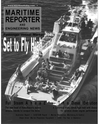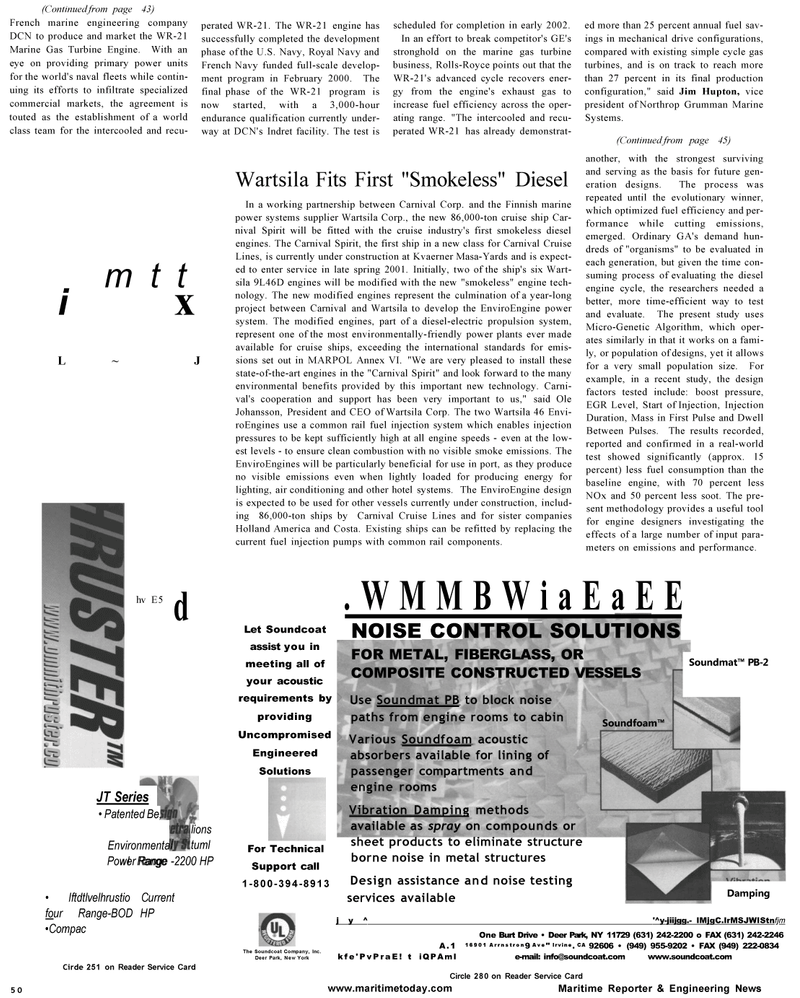
Page 50: of Maritime Reporter Magazine (January 2001)
Read this page in Pdf, Flash or Html5 edition of January 2001 Maritime Reporter Magazine
(Continued from page 43)
French marine engineering company
DCN to produce and market the WR-21
Marine Gas Turbine Engine. With an eye on providing primary power units for the world's naval fleets while contin- uing its efforts to infiltrate specialized commercial markets, the agreement is touted as the establishment of a world class team for the intercooled and recu-
Cirde 251 on Reader Service Card 50 perated WR-21. The WR-21 engine has successfully completed the development phase of the U.S. Navy, Royal Navy and
French Navy funded full-scale develop- ment program in February 2000. The final phase of the WR-21 program is now started, with a 3,000-hour endurance qualification currently under- way at DCN's Indret facility. The test is scheduled for completion in early 2002.
In an effort to break competitor's GE's stronghold on the marine gas turbine business, Rolls-Royce points out that the
WR-21's advanced cycle recovers ener- gy from the engine's exhaust gas to increase fuel efficiency across the oper- ating range. "The intercooled and recu- perated WR-21 has already demonstrat- ed more than 25 percent annual fuel sav- ings in mechanical drive configurations, compared with existing simple cycle gas turbines, and is on track to reach more than 27 percent in its final production configuration," said Jim Hupton, vice president of Northrop Grumman Marine
Systems. (Continued from page 45) another, with the strongest surviving and serving as the basis for future gen- eration designs. The process was repeated until the evolutionary winner, which optimized fuel efficiency and per- formance while cutting emissions, emerged. Ordinary GA's demand hun- dreds of "organisms" to be evaluated in each generation, but given the time con- suming process of evaluating the diesel engine cycle, the researchers needed a better, more time-efficient way to test and evaluate. The present study uses
Micro-Genetic Algorithm, which oper- ates similarly in that it works on a fami- ly, or population of designs, yet it allows for a very small population size. For example, in a recent study, the design factors tested include: boost pressure,
EGR Level, Start of Injection, Injection
Duration, Mass in First Pulse and Dwell
Between Pulses. The results recorded, reported and confirmed in a real-world test showed significantly (approx. 15 percent) less fuel consumption than the baseline engine, with 70 percent less
NOx and 50 percent less soot. The pre- sent methodology provides a useful tool for engine designers investigating the effects of a large number of input para- meters on emissions and performance. mtt i x
L ~ J hv E5 d
JT Series • Patented Be, lions tuml
Power Range -2200 HP
Environmental
I Range • Iftdtlvelhrustio Current four Range-BOD HP •Compac
Wartsila Fits First "Smokeless" Diesel
In a working partnership between Carnival Corp. and the Finnish marine power systems supplier Wartsila Corp., the new 86,000-ton cruise ship Car- nival Spirit will be fitted with the cruise industry's first smokeless diesel engines. The Carnival Spirit, the first ship in a new class for Carnival Cruise
Lines, is currently under construction at Kvaerner Masa-Yards and is expect- ed to enter service in late spring 2001. Initially, two of the ship's six Wart- sila 9L46D engines will be modified with the new "smokeless" engine tech- nology. The new modified engines represent the culmination of a year-long project between Carnival and Wartsila to develop the EnviroEngine power system. The modified engines, part of a diesel-electric propulsion system, represent one of the most environmentally-friendly power plants ever made available for cruise ships, exceeding the international standards for emis- sions set out in MARPOL Annex VI. "We are very pleased to install these state-of-the-art engines in the "Carnival Spirit" and look forward to the many environmental benefits provided by this important new technology. Carni- val's cooperation and support has been very important to us," said Ole
Johansson, President and CEO of Wartsila Corp. The two Wartsila 46 Envi- roEngines use a common rail fuel injection system which enables injection pressures to be kept sufficiently high at all engine speeds - even at the low- est levels - to ensure clean combustion with no visible smoke emissions. The
EnviroEngines will be particularly beneficial for use in port, as they produce no visible emissions even when lightly loaded for producing energy for lighting, air conditioning and other hotel systems. The EnviroEngine design is expected to be used for other vessels currently under construction, includ- ing 86,000-ton ships by Carnival Cruise Lines and for sister companies
Holland America and Costa. Existing ships can be refitted by replacing the current fuel injection pumps with common rail components.
Let Soundcoat assist you in meeting all of your acoustic requirements by providing
Uncompromised
Engineered
Solutions
For Technical
Support call 1-800-394-8913
The Soundcoat Company, Inc.
Deer Park, New York
Circle 280 on Reader Service Card www.maritimetoday.com Maritime Reporter & Engineering News jy^ '^y-jiijgg.- IMjgC.lrMSJWIStnfjm
One Burt Drive • Deer Park, NY 11729 (631) 242-2200 o FAX (631) 242-2246
A.1 16901 Arrnstron9 Ave" lrvine. CA 92606 • (949) 955-9202 • FAX (949) 222-0834 kfe'PvPraE! t iQPAml e-mail: [email protected] www.soundcoat.com .WMMBWiaEaEE
NOISE CONTROL SOLUTIONS
FOR METAL, FIBERGLASS, OR
COMPOSITE CONSTRUCTED VESSELS Soundmat™ PB-2
Design assistance and noise testing services available
Soundfoam™
Damping
Use Soundmat PB to block noise paths from engine rooms to cabin
Various Soundfoam acoustic absorbers available for lining of passenger compartments and engine rooms
Vibration Damping methods available as spray on compounds or sheet products to eliminate structure borne noise in metal structures

 49
49

 51
51
